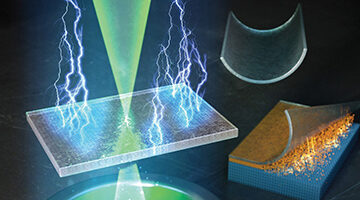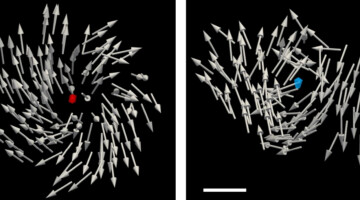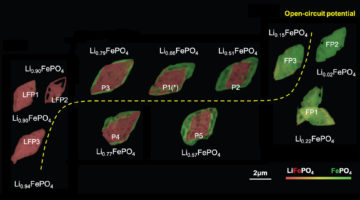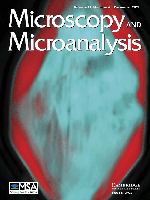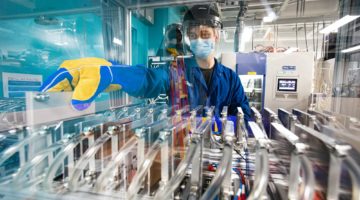By directly visualizing the uneven insertion of lithium ions into electrodes with well-defined crystal orientations, researchers learned why fast charging decreases battery lifespan and performance. The work could provide insights into better battery utilization and help investigations of the surface insertion reaction during fast charging. Read more »![]()
![]()
Elucidating Heterogeneous Li Insertion Using Single-Crystalline and Freestanding Layered Oxide Thin Film
The nanoscale surface insertion of lithium in a single-crystalline and freestanding LiNi1/3Mn1/3Co1/3O2 thin film is elucidated using in situ scanning transmission x-ray microscopy. The realization of advanced analysis through freestanding thin films is expected to be applicable to other systems subjected to external stimuli, such as hydrogen storage alloys, in the field of materials science. Read more »
Will Chueh to Receive the 2023 Shirley Award
Will Chueh of Stanford University is the 2023 winner of the Shirley award for Outstanding Scientific Achievement at the ALS. His selection recognizes Chueh’s deep contributions in operando soft x-ray spectromicroscopy for imaging electrochemical redox phenomena—images and movies for battery and electrocatalytic reactions. Read more »
Imaging Topological Magnetic Monopoles in 3D
Researchers created topologically stable magnetic monopoles and imaged them in 3D with unprecedented spatial resolution using a technique developed at the ALS. The work enables the study of magnetic monopole behavior for both fundamental interest and potential use in information storage and transport applications. Read more »![]()
![]()
A Machine-Learning Approach to Better Batteries
Researchers extracted the relationship between strain and composition in a battery material by applying machine-learning methods to atomic-scale images. The work could lead to more durable batteries and also highlights the potential of integrating microscopy techniques with machine learning to gain insights into complex materials. Read more »![]()
![]()
Enhancing the inherent catalytic activity and stability of TiO2 supported Pt single-atoms at CeOx–TiO2 interfaces
Single atoms with atomically coordinated reaction centers are considered next-generation catalysts. However, there is concern about their thermodynamic vulnerabilities and whether their inherent catalytic nature is superior compared with that of larger nanoparticles. Here, we address the two controversies by a comparative study using two catalysts. Read more »
How X-Rays Can Make Better Batteries
In order to help our nation meet its goal of net-zero carbon emissions by 2050, scientists like William Chueh and David Shapiro are working together to come up with new strategies to design safer, long-distance batteries made from sustainable, Earth-abundant materials. They discuss their pioneering work in this Q&A. Read more »
Ptychography Reduces Spectral Distortions Intrinsic to Conventional Zone-Plate-Based X-Ray Spectromicroscopy
The point spread function (PSF) of a conventional zone-plate-based microscope limits the achievable spatial resolution and results in spatially resolved spectra that do not accurately reflect the spatial heterogeneity of the samples when the scale of the detail approaches the probe size. X-ray ptychography, a coherent-scattering-based imaging scheme that effectively removes the probe from the image data, returns accurate spectra from regions smaller than the probe size. Read more »
A Multiscale Picture of Oxygen Loss in Battery Electrodes
In lithium-ion batteries, oxygen atoms leak out of electrode particles as the lithium moves back and forth between electrodes. Now, researchers have measured this process at multiple length scales, showing how the oxygen loss changes the electrode’s structure and chemistry, gradually reducing the amount of energy it can store. Read more »
X-Ray Experiments, Machine Learning Could Trim Years Off Battery R&D
Scanning transmission x-ray microscopy at the ALS’s COSMIC beamline contributed to a battery study that used an innovative approach to machine learning to speed up the learning curve about a process that shortens the life of fast-charging lithium batteries. It represents the first time this brand of “scientific machine learning” was applied to battery cycling. Read more »
